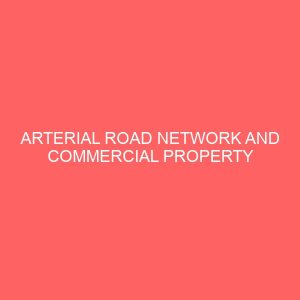Description
CHAPTER ONE
INTRODUCTION
1.1 Background to the Study
Transportation and property are important in physical and economic development of towns and cities all over the world. Property and land values tend to increase in areas with expanding transportation networks, and increase less rapidly in areas without such improvements. Rapid and continued rise in housing and land prices are expected in cities with transportation improvements and rapid economic and population growth Goldberg, 1970.
Man, nations, regions and the world would be severely limited in development
without transportation, which is a key factor for physical and economic growth
Oyesiku, 2002. Transportation systems and land use are interdependent. Indeed
findings of earlier studies indicate compelling and consistent connections amongst
them Ewing and Cervero, 2001; Polzin, 2004. According to Bailey, Mokhtarian, and
Littlel 2008, transportation route is part of distinct development pattern or road
network and mostly described by regular street patterns as an indispensable factor of
human existence, development and civilization. The route network coupled with
increased transport investment result in changed levels of accessibility reflected
through Cost Benefit Analysis, savings in travel time, and other benefits. These
benefits are noticeable in increased catchment areas for services and facilities like
shops, schools, offices, banks, and leisure activities.
Road networks are observed in terms of its components of accessibility,
connectivity, traffic density, level of service, compactness, and density of particular
roads. Level of service is a measure by which the quality of service on transportation
devices or infrastructure is determined, and it is a holistic approach considering
several factors regarded as measures of traffic density and congestion rather than
overall speed of the journey Mannering, Walter, and Scott, 2004.
Access to major roads provides relative advantages consequent upon which
commercial users locate to enjoy the advantages. Modern businesses, industries,
trades and general activities depend on transport and transport infrastructure, with
movement of goods and services from place to place becoming vital and inseparable
aspects of global and urban economic survival. Developments of various
transportation modes have become pivotal to physical and economic developments.
Such modes include human porterage, railways, ropeways and cableways, pipelines,
inland waterways, sea, air, and roads Said and Shah, 2008.
According to Oyesiku 2002, urbanization in Nigeria has a long history in its
growth and development. Extensive development being a feature of the 19th and 20th
centuries, with concentration of economic and administrative decisionmaking in
Lagos, Ibadan, Kaduna, Jos, and Enugu, and high degree of specialization and larger
population associated with greater specialization of goods and services. Wyatt 1997
states that urban areas have tendency to develop at nodal points in transport network
and places with good road network will possess relative advantage over locations
having poor network. Urban locations with such relative advantage are found where
different transport routes converge with high degree of compactness, connectivity,
density, length and accessibility exhibited within the intra and inter urban road
networks.
Ikeja is a typical example in the history of growth and development of cities in
Nigeria. The city became capital of Lagos State in 1976 with improved road networks
developed to cater for increase in concentration of pedestrian and vehicular
movements. Similarly, commercial activities like banking, retail/wholesale
businesses, and professional services congregated to take advantage of nearness to
seat of governance. Concentration of activities attracted consumers and ancillary
service providers. This partly caused increase in demand for commercial space and its
concomitant effects on commercial property values along arterial roads in the
metropolis.
The present position concerning commercial properties in Ikeja is that
majority are located along arterial roads that deliver much of the vehicular and
pedestrian movements. There have been increases in rental values along the individual
arterial roads although not at equal rates. It is against this background that this
research analyzed the arterial roads, determined the levels of accessibility,
connectivity, traffic density of the individual arterial roads, examined the pattern of commercial property values and the relationship between the explanatory variables of
the road network in Ikeja Nigeria.
1.2 Statement of the Research Problem
The relationship between transportation and urban property values has been the focus
of many studies for example, Dewees, 1976; Damm et al, 1980; Wolf, 1992; Singh,
2005. Some of the earlier studies returned positive relationship between transport and
property values while others showed negative relationship. For instance, in a study on
the relationship between rail travel cost and residential property values, a replacement
of streetcar with subway increased site rent at a location that is perpendicular to the
facility within a onethird mile walk to the station Dewees, 1976; and there was
positive influence of permanent transportation improvements on land values Wolf,
1992. It was established that there was statistically significant relationship between
distance of a parcel of land to the nearest Metro station and land price Damm,
LernerLam, and Young, 1980, while there was evidence that residential property
prices decrease immediately around the transport investment or station value uplift
through changes in land values Singh, 2005.
The urban areas all over the world offer a number of advantages in terms of
concentration of people followed by demand for commercial properties and
transportation. Ikeja is a classical example of a city that has developed rapidly since
1976 when it became the Lagos State capital. Construction of roads increased
substantially with the opening up of residential precincts that also benefitted from
increasing demand for lettable spaces in commercial properties. Many private
companies, retail stores, commercial banks aggregate in the metropolis to take
advantage of opportunities afforded by locations near the seat of governance thus
attracting complimentary services. This led to high concentration of vehicular and
pedestrian movements especially along the access roads.
The roads exhibit a number of nodes and linkages to form networks of both
arterial and minor routes along which commercial properties locate. Commercial
users displaced residential users, causing sites to be at highest and best uses with
concomitant increases in the values of commercial properties. Accessibility within the
road network is affected by the compact nature of various routes that sometimes impede volume of traffic. The road network is made up of nodal points and links that
determine the degree of connectivity and accessibility in the network.
A number of factors affect values of properties. These factors may be intrinsic
or extrinsic. The extrinsic factors include increase in demand for lettable space,
location, condition of adjoining properties, nearness to park and leisure, local and
national economic conditions. External factors are due to natural characteristics of the
property which affect the city where the property is located. Intrinsic factors arise
from within the nature of the property itself and relate to the physical attributes,
including size of room, state of repair, decoration, and facilities. Other attributes that
increase or decrease the amount that users are willing and able to pay in an open
market transaction include physical characteristics of the structure, change in taste and
demand, effect of adjacent activities, economic activities, inflation, and changes in
legislation. The demand for commercial properties itself is affected by changes in
population, planning and development schemes, legislation, and availability of good
road networks Hendon, 1971; William, Davies, and Johnson, 1980; Richmond, 1982;
Millington, 1982; Olayiwola, Adeleye and Oduwaye, 2006.
Earlier theorists Burgess, 1925; Hoyt, 1939; Harris and Ullman, 1951; Lean
and Goodall, 1977 generally believe that sites adjacent to main transport routes have
relative advantages over those located some distance away, and other sites located at
route intersections possess relative advantage with greater advantages belonging to
sites located at focus of transport system. These advantages are determined in relation
to accessibility, which has different characteristics in relation to individual sites thus
differentiating between sites in terms of accessibility advantages.
Many of the aforementioned studies emphasized the effects of the factors on
values of properties generally with little consideration given to road network pattern
and its effects on values of commercial properties. Possible relationships between
road networks, location attribute, demand and supply, and accessibility and
commercial property values have therefore elicited the interest of the researcher in
this direction. The relationship cannot be determined without due consideration given
to the explanatory variables on one hand and commercial property values on the other.
The use of roads leads to a study of urban areas in relation to land uses, especially
commercial properties. It is against this background that this study was conceived.
1.3 Research Questions
The foregoing has elicited a number of questions in terms of road network analysis
and values of commercial properties in Ikeja, Nigeria to which answers are to be
proffered. The relationship between arterial road network and commercial property
values cannot be determined without due consideration given to variables that make
up the network, especially those that relate to arterial roads and other explanatory
variables and values of commercial properties. Some pertinent questions to enable the
study attain its stated objectives are as follows:
1. What is the pattern of arterial roads in Ikeja
2. What are the spatial pattern and trend of commercial property values in the study
area
3. What are the relationships between commercial property values and arterial road
network in the presence or absence of other explanatory variables
4. What are the individual contributions of the explanatory variables to variability in
commercial property values
5. What are the models to explain and predict the relationship between the
explanatory variables and commercial property values
1.4 Aim and Objectives of the Research
The aim of this research is to analyze the network of arterial roads and other
explanatory variables and commercial property values in Ikeja, while the specific
objectives are to:
a. Analyze the arterial road network pattern in the study area;
b. Examine the spatial pattern and trend of demand, supply and values of
commercial properties in the study area;
c. Determine the relationships between commercial property values and road
network, in the presence or absence of other variables, in the study area;
d. Determine the contributions of individual explanatory variables to variability in
commercial property values in the study area;
e. Derive models for predicting variability in commercial property values in relation to the explanatory variables.








Margarett –
keep doing your best to help students, thanks for this research material
gralion torile –
tremendous things here.